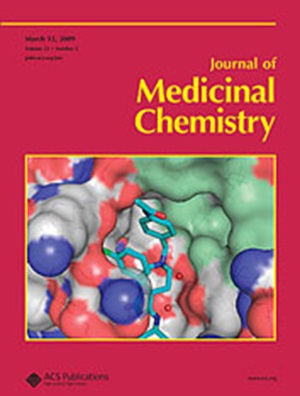分子水平上自下而上获取高效抗菌肽的策略
IF 6.8
1区 医学
Q1 CHEMISTRY, MEDICINAL
引用次数: 0
摘要
多药耐药病原体的威胁日益加剧,需要高效的抗菌药物开发,其中抗菌肽(AMPs)由于其广谱抗菌活性而得到广泛研究。结合和频生成和分子动力学模拟,确定两种结构原理,合理设计amp。简单地增加碱性氨基酸的数量并不能可靠地提高抗菌效果;末端(N′和C′)苯丙氨酸残基可以通过疏水作用增强AMP的膜界面活性。经过两轮序列优化,在我们设计的衍生物中,名为GF的人工AMP表现出优异的膜结合(特别是插入)和空间构象稳定性。体外和体内评价显示GF对普通细菌和耐药细菌具有潜在的广谱疗效。值得注意的是,GF在较低浓度下比常规抗生素表现出更强的抗菌效力。我们的研究建立了一个自下而上(机制驱动)的设计框架,并为开发针对耐药感染的精确抗菌剂提供了模板。本文章由计算机程序翻译,如有差异,请以英文原文为准。

Molecular-Level Strategy from Bottom-Up to Acquire High-Efficiency Antimicrobial Peptides
The escalating threat of multidrug-resistant pathogens necessitates efficient antimicrobial development, in which antimicrobial peptides (AMPs) have been extensively studied due to their broad-spectrum antibiotic activity. Combining sum frequency generation and molecular dynamics simulation, we rationally designed AMPs by identifying two structural principles. Simply increasing the number of basic amino acids does not reliably improve antimicrobial efficacy; terminal (N’ and C’) phenylalanine residues can enhance AMP’s membrane interfacial activity via the hydrophobic effect. After two rounds of sequence optimization, among the derivatives we designed, an artificial AMP named GF demonstrated superior membrane binding (especially insertion) and spatial conformation stability. In vitro and in vivo evaluations revealed GF’s potential broad-spectrum efficacy against common bacteria and drug-resistant bacteria. Notably, GF exhibited enhanced antimicrobial potency over conventional antibiotics at lower concentrations. Our study established a bottom-up (mechanism-driven) design framework and provided a template for developing precision antimicrobials against resistant infections.
求助全文
通过发布文献求助,成功后即可免费获取论文全文。
去求助
来源期刊

Journal of Medicinal Chemistry
医学-医药化学
CiteScore
4.00
自引率
11.00%
发文量
804
审稿时长
1.9 months
期刊介绍:
The Journal of Medicinal Chemistry is a prestigious biweekly peer-reviewed publication that focuses on the multifaceted field of medicinal chemistry. Since its inception in 1959 as the Journal of Medicinal and Pharmaceutical Chemistry, it has evolved to become a cornerstone in the dissemination of research findings related to the design, synthesis, and development of therapeutic agents.
The Journal of Medicinal Chemistry is recognized for its significant impact in the scientific community, as evidenced by its 2022 impact factor of 7.3. This metric reflects the journal's influence and the importance of its content in shaping the future of drug discovery and development. The journal serves as a vital resource for chemists, pharmacologists, and other researchers interested in the molecular mechanisms of drug action and the optimization of therapeutic compounds.
 求助内容:
求助内容: 应助结果提醒方式:
应助结果提醒方式:


